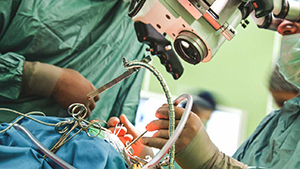Trigeminal Neuralgia
Conveniently Located to Serve Dallas, Fort Worth, and the entire State of Texas
 Trigeminal neuralgia, also known as tic douloureux, is a facial pain condition that causes the sufferer to experience sharp jolts of facial pain that feel like electrical shocks. The pain typically only affects one side of the face, but in rare cases, pain can occur on both sides of the face. Individuals who suffer from trigeminal neuralgia can experience episodes of pain as a result of mild facial stimulation, such as:
Trigeminal neuralgia, also known as tic douloureux, is a facial pain condition that causes the sufferer to experience sharp jolts of facial pain that feel like electrical shocks. The pain typically only affects one side of the face, but in rare cases, pain can occur on both sides of the face. Individuals who suffer from trigeminal neuralgia can experience episodes of pain as a result of mild facial stimulation, such as:
- Brushing their teeth
- Applying makeup
- Chewing
- Talking
- Drinking
- Smiling
- Touching their face
In some cases, the feeling of a light breeze on the individual’s face can trigger a painful episode. This makes a living with trigeminal neuralgia incredibly difficult and can lead to a significant decrease in quality of life.
Symptoms
The pain caused by trigeminal neuralgia is commonly described as sharp, sudden, and severe. While most people describe the pain as being similar to an electrical shock, others have described the pain as a stabbing, crushing, or shooting pain that can be extremely difficult to manage.
Trigeminal neuralgia typically occurs in episodes that can last seconds, minutes, or hours. The frequency of these episodes can vary greatly. The number of episodes a patient experiences can range from just a handful to over 50 per day. Classically, patients experience “pain-free” episodes between the attacks of electrical shock, meaning they have no pain between attacks. But there is also a variant called “Type II Trigeminal Neuralgia” in which patients have underlying chronic pain in the face, which is there more than 50% of the time. The pain of trigeminal neuralgia can wax and wane over time, and can sometimes go away for months or years before coming back.
Causes
The trigeminal nerve is the main nerve that gives sensation to the face. Each nerve (one on each side) separates into three main branches that spread across the upper and lower face.
While the exact cause of trigeminal neuralgia is still not completely understood, there are many theories about what causes the pain. In some cases, a blood vessel may run right next to the nerve where it comes out of the brain. The pulsation of this blood vessel can irritate the nerve and cause pain. The pulsations can cause damage to the protective sheath around the nerve and may cause the nerve to become hyperactive. Other potential causes of trigeminal neuralgia include:
- Tumors
- Multiple sclerosis
- Brian lesions and abnormalities
It is important to recognize that not all facial pain is necessarily trigeminal neuralgia. We differentiate the different types of facial pain based on history, pattern and sensation of pain, associated symptoms, and response to treatment. Other causes of facial pain include:
- Atypical facial pain
- Trauma to the face
- Stroke
- Cluster headache and other trigeminal autonomic cephalalgias
Treatment Options
Like many other pain syndromes, treatment of trigeminal neuralgia is initiated after making a diagnosis and when symptoms become bothersome. First-line therapies include medications such as carbamazepine (Tegretol) or oxcarbazepine (Trileptal). Other medications that can be tried include baclofen, gabapentin, and lyrica.
When medications are inadequate, we consider surgical interventions. The gold standard therapy is a surgery called microvascular decompression (MVD), in which brain surgery is done to move the blood vessel off of the nerve. However, MVD is not the best option for all patients, depending on symptoms, age, and general health. Other options include more minimally invasive surgical options like percutaneous balloon compression and radiofrequency ablation as well as stereotactic radiosurgery. Each procedure has specific advantages and limitations, including how quickly it works, success rates, side effects, and risk of recurrence after successful treatment.
How Much Does Trigeminal Neuralgia Cost?
The cost of Trigeminal Neuralgia will depend on several factors. The price can be affected by body type, type of technique performed, surgical complications, and even allergies. Find out more by scheduling a consultation.
Schedule a Consultation
Schedule your consultation for Trigeminal Neuralgia in Dallas– contact Dr. Nader Pouratian and set up your appointment. During your appointment, you will be able to ask questions and bring up any concerns you may have about the procedure. Contact us today to get the look you’ve always wanted!
Related Blogs

Treating Trigeminal Neuralgia with Balloon Compression
Trigeminal neuralgia is a chronic condition that causes a person to experience sharp jolts of pain in the face. The pain typically occurs in episodes that vary in severity and length… Read More

How Brain Surgery Stops Parkinson’s Disease Tremors
Experts say two types of brain surgery can have immediate results for Parkinson’s disease patients. However, they say oral medications should be tried first… Read More

UCLA neurosurgeons utilize virtual reality in treating patients
Pediatric neurosurgeon Aria Fallah donned virtual reality goggles and exchanged his surgical tools for two remotes to practice a brain surgery… Read More




